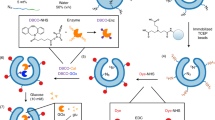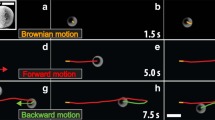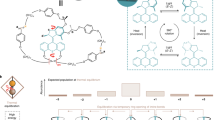Abstract
Polymer stomatocytes are bowl-shaped structures of nanosize dimensions formed by the controlled deformation of polymer vesicles. The stable nanocavity and strict control of the opening are ideal for the physical entrapment of nanoparticles which, when catalytically active, can turn the stomatocyte morphology into a nanoreactor. Herein we report an approach to generate autonomous movement of the polymer stomatocytes by selectively entrapping catalytically active platinum nanoparticles within their nanocavities and subsequently using catalysis as a driving force for movement. Hydrogen peroxide is free to access the inner stomatocyte cavity, where it is decomposed by the active catalyst (the entrapped platinum nanoparticles) into oxygen and water. This generates a rapid discharge, which induces thrust and directional movement. The design of the platinum-loaded stomatocytes resembles a miniature monopropellant rocket engine, in which the controlled opening of the stomatocytes directs the expulsion of the decomposition products away from the reaction chamber (inner stomatocyte cavity).
This is a preview of subscription content, access via your institution
Access options
Subscribe to this journal
Receive 12 print issues and online access
$259.00 per year
only $21.58 per issue
Buy this article
- Purchase on Springer Link
- Instant access to full article PDF
Prices may be subject to local taxes which are calculated during checkout




Similar content being viewed by others
References
Spudich, J. A. Molecular motors, beauty in complexity. Science 331, 1143–1144 (2011).
Schliwa, M. & Woehlke, G. Molecular motors. Nature 422, 759–765 (2003).
van den Heuvel, M. G. L. & Dekker, C. Motor proteins at work for nanotechnology. Science 317, 333–336 (2007).
Kay, E. R., Leigh, D. A. & Zerbetto, F. Synthetic molecular motors and mechanical machines. Angew. Chem. Int. Ed. 46, 72–191 (2007).
Koumura, N., Zijlstra, R. W., van Delden, R. A., Harada, N. & Feringa, B. L. Light-driven monodirectional molecular motor. Nature 401, 152–155 (1999).
Kelly, T. R., De Silva, H. & Silva, R. A. Unidirectional rotary motion in a molecular system. Nature 401, 150–152 (1999).
Leigh, D. A., Wong, J. K. Y., Dehez, F. & Zerbetto, F. Unidirectional rotation in a mechanically interlocked molecular rotor. Nature 424, 174–179 (2003).
Badjic, J. D., Balzani, V., Credi, A., Silvi, S. & Stoddart, J. F. A molecular elevator. Science 303, 1845–1849 (2004).
Hawthorne, M. F. et al. Electrical or photocontrol of the rotary motion of a metallacarborane. Science 303, 1849–1851 (2004).
Fletcher, S. P., Dumur, F., Pollard, M. M. & Feringa, B. L. A reversible, unidirectional molecular rotary motor driven by chemical energy. Science 310, 80–82 (2005).
Mao, C., Sun, W., Shen, Z. & Seeman, N. C. Construction of a DNA nanomechanical device. Nature 397, 144–146 (1999).
Kudernac, T. et al. Electrically driven directional motion of a four-wheeled molecule on a metal surface. Nature 479, 208–211 (2011).
Ismagilov, R., Schwartz, A., Bowden, N. & Whitesides, G. M. Autonomous movement and self-assembly. Angew. Chem. Int. Ed. 41, 652–654 (2002).
Paxton, W. et al. Catalytic nanomotors: autonomous movement of striped nanorods. J. Am. Chem. Soc. 126, 13424–13431 (2004).
Kline, T., Paxton, W. & Mallouk, T. Catalytic nanomotors: remote-controlled autonomous movement of striped metallic nanorods. Angew. Chem. Int. Ed. 117, 754–756 (2005).
Demirok, U., Laocharoensuk, R., Manesh, K. M. & Wang, J. Ultrafast catalytic alloy nanomotors. Angew. Chem. Int. Ed. 120, 9489–9491 (2008).
Gao, W., Sattayasamitsahit, S., Orozco, J. & Wang, J. Highly efficient catalytic microengines: template electrosynthesis of polyaniline/platinum microtubes. J. Am. Chem. Soc. 133, 11862–11864 (2011).
Solovev, A., Mei, Y., Urena, E. B., Huang, G. & Schmidt, O. G. Catalytic microtubular jet engines self-propelled by accumulated gas bubbles. Small 14, 1688–1692 (2009).
Sanchez, S., Solovev, A., Harazim, S. M. & Schmidt, O. G. Microbots swimming in the flowing streams of microfluidic channels. J. Am. Chem. Soc. 133, 701–703 (2011).
van Delden, J. R. A. et al. Unidirectional molecular motor on a gold surface. Nature 437, 1337–1340 (2005).
Wu, J. et al. Motion-based DNA detection using catalytic nanomotors. Nature Commun. 1, 1–6 (2010).
Manesh, K. M. et al. Template-assisted fabrication of salt-independent catalytic tubular microengines. ACS Nano 4, 1799–1804 (2010).
Balasubramanian, S. et al. Micromachine-enabled capture and isolation of cancer cells in complex media. Angew. Chem. Int. Ed. 123, 4247–4250 (2011).
Pumera, M. Electrochemically powered self-propelled electrophoretic nanosubmarines. Nanoscale 2, 1643–1649 (2010).
Mei, Y., Solovev, A. A., Sanchez, S. & Schmidt, O. G. Rolled-up nanotech on polymers: from basic perception to self-propelled catalytic microengines. Chem. Soc. Rev. 40, 2109–2119 (2011).
Gibbs, J. G. & Zhao, Y. P. Autonomously motile catalytic nanomotors by bubble propulsion. Appl. Phys. Lett. 94, 163104–163104 (2009).
Valadares, L. F. et al. Catalytic nanomotors: self-propelled sphere dimers. Small 6, 565–572 (2010).
Gibbs, J. G., Kothari, S., Saintillan, D. & Zhao, Y-P. Geometrically designing the kinematic behavior of catalytic nanomotors. Nano Lett. 11, 2543–2550 (2011).
Howse, J. R. et al. Self-motile colloidal particles: from directed propulsion to random walk. Phys. Rev. Lett. 99, 048102 (2007).
Discher, B. M. et al. Polymersomes: tough vesicles made from diblock copolymers. Science 284, 1143–1146 (1999).
Discher, D. E. & Eisenberg, A. Polymer vesicles. Science 297, 967–973 (2002).
Percec, V. et al. Self-assembly of Janus dendrimers into uniform dendrimersomes and other complex architectures. Science 328, 1009–1014 (2010).
Kim, K. T. et al. Polymersome stomatocytes: controlled shape transformation in polymer vesicles. J. Am. Chem. Soc. 132, 12522–12524 (2010).
Yu, Y. & Eisenberg, A. Control of morphology through polymer–solvent interactions in crew-cut aggregates of amphiphilic block copolymers. J. Am. Chem. Soc. 119, 8383–8384 (1997).
Burda, C., Chen, X., Narayanan, R. & El-Sayed, M. A. Chemistry and properties of nanocrystals of different shapes. Chem. Rev. 105, 1025–1102 (2005).
Kotov, N. Inorganic nanoparticles as protein mimics. Science 330, 188–189 (2010).
Wang, L. & Yamauchi, Y. Block copolymer mediated synthesis of dendritic platinum nanoparticles. J. Am. Chem. Soc. 131, 9152–9153 (2009).
Filipe, V., Hawe, A. & Jiskoot, W. Critical evaluation of nanoparticle tracking analysis (NTA) by nanosight for the measurement of nanoparticles and protein aggregates. Pharm. Res. 27, 796–810 (2010).
Ebbens, S. J. & Howse, J. R. Direct observation of the direction of motion for spherical catalytic swimmers. Langmuir 27, 12293–12296 (2011).
Acknowledgements
This work was supported by the Dutch Science Foundation (NWO/CW) under the VICI-project ‘Kinetically controlled peptide–polymer artificial organelles’. D.A.W. and R.J.M.N. acknowledge financial support from the Royal Netherlands Academy of Science. The authors thank M. Ware, A. Siupa and J. Sullivan from the Nanosight Company for technical assistance.
Author information
Authors and Affiliations
Contributions
D.A.W., J.C.M.v.H. and R.J.M.N. conceived and designed the experiments. D.A.W. performed the experiments.
Corresponding authors
Ethics declarations
Competing interests
The authors declare no competing financial interests.
Supplementary information
Supplementary information
Supplementary information (PDF 4121 kb)
Rights and permissions
About this article
Cite this article
Wilson, D., Nolte, R. & van Hest, J. Autonomous movement of platinum-loaded stomatocytes. Nature Chem 4, 268–274 (2012). https://doi.org/10.1038/nchem.1281
Received:
Accepted:
Published:
Issue Date:
DOI: https://doi.org/10.1038/nchem.1281
This article is cited by
-
Superstructural ordering in self-sorting coacervate-based protocell networks
Nature Chemistry (2024)
-
Convoluted micellar morphological transitions driven by tailorable mesogenic ordering effect from discotic mesogen-containing block copolymer
Nature Communications (2024)
-
Recent Progress and Future Prospects of Laccase Immobilization on MOF Supports for Industrial Applications
Applied Biochemistry and Biotechnology (2024)
-
Advances of medical nanorobots for future cancer treatments
Journal of Hematology & Oncology (2023)
-
Smart micro- and nanorobots for water purification
Nature Reviews Bioengineering (2023)



